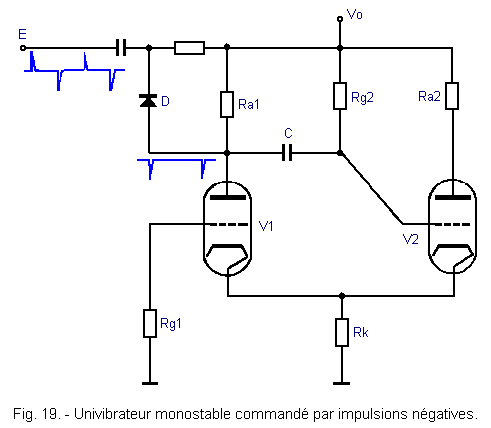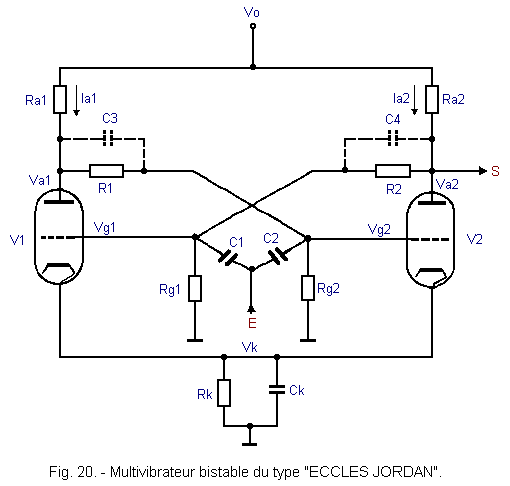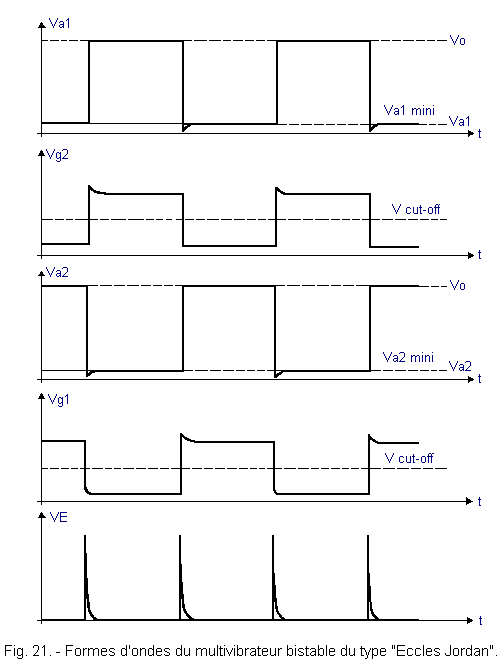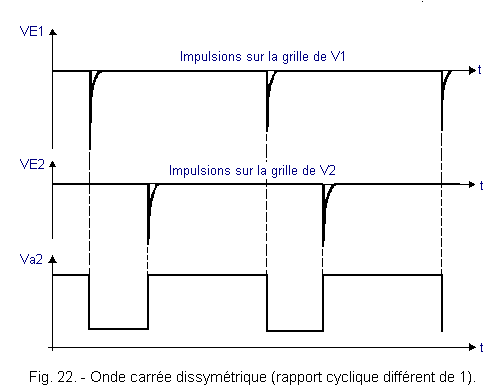c) BY NEGATIVE IMPULSES ON THE ANODE OF V1
This injection mode requires very large amplitude pulses.
The negative signal applied in this way decreases the voltage of Va1. The capacitor C transmits the variation on the gate of V2 and the tube V2 is blocked. The voltage Vk decreases and V1 begins to drive.
The capacitor C can be discharged through V1 and Rg2 and the discharge current keeps the tube V2 blocked until the voltage Vg2 reaches the unlocking voltage.
In most cases, the signal applied to the monostable multivibrator is composed of positive and negative pulses (these pulses are obtained by applying a square voltage to a differentiating RC circuit).
The control being carried out either with positive peaks or with negative peaks, it is necessary to eliminate unnecessary pulses.
For this purpose, a diode connected is used so as to let only the pulses having the desired polarity pass.
Figure 19 shows a univibrator controlled by the negative pulses on the anode of V1.
Diode D blocks the positive pulses and passes the negative pulses.

 6. - BISTABLE MULTIVIBRATOR
6. - BISTABLE MULTIVIBRATOR
The assemblies we are going to study now, have two stable states and they are essentially designed to move from one state to another, when sending a command pulse on a given input. These are the bistable multivibrators.
6. 1. - BISTABLE MULTIVIBRATOR OF THE TYPE "ECCLES JORDAN"
The diagram of a bistable multivibrator "ECCLES JORDAN" is given figure 20.

This assembly is deduced from the "ABRAHAM BLOCH" multivibrator by replacing the two connecting capacitors with resistors.
The new circuit now has two direct links. It is always a tilting mount (one of the tubes is conductive while the other is blocked), but because of the direct links, one or the other state is maintained indefinitely, as long as no external cause modify it.
The control is effected by positive pulses applied simultaneously, through C1 and C2, to the control gates of the two triodes.
OPERATION OF THE ASSEMBLY
As soon as the circuit is switched on, both tubes start driving.
Despite the symmetry of the circuits, currents Ia1 and Ia2 are not perfectly equal.
These two currents, crossing Rk, give a cathode polarization Vk common to both tubes.
The gate bias voltages of the triodes are given by the currents flowing in the resistor bridges R1, Rg2 and R2, Rg1.
These voltages are positive and depend directly on the values taken by the anode voltages of each tube.
The grid voltage of the tube V1 is given by the expression :

We immediately notice that for each tube, the gate and cathode voltages are positive.
The positive voltage on the cathode having the same effect as a negative voltage on the gate, we can write that the bias voltage Vgo is equal to the difference between Vk and Vg.
For the tube V1, we obtain Vgo1 = Vg1 - Vk and for the tube V2, Vgo2 = Vg2 - Vk.
For the tubes to operate under normal conditions (negative Vgo or at most 0 volt), the gate voltages Vg1 and Vg2 must be lower than the cathode voltage.
Suppose Ia1 is larger than Ia2. The voltage drops in the resistors Ra1 and Ra2 are unequal and therefore Va1 is lower than Va2.
Since R1 = R2 and Rg1 = Rg2, the values Vg1 and Vg2 are no longer equal and we obtain Vg1 larger than Vg2.
The polarization of the tube V1 (Vg1 - Vk) is lower than that of the tube V2 (Vg2 - Vk). As a result, the triode V1 leads even more than V2.
Very quickly and thanks to the cumulative effect, the tube V1 will lead to the maximum and V2 will be blocked, (polarization below the cut-off voltage).
Without external action, the system remains infinitely in this stable state.
Apply to the input E, a positive pulse of sufficient amplitude to unlock V2.
This impulse also arrives on the grid of V1, but as this tube already leads, it does not cause any important reaction.
On the other hand, the pulse unlocks the tube V2. This results in a sudden decrease in the anode voltage Va2 and consequently a decrease in Vg1.
At the same time, the anode current Ia2 is added in Rk to the anode current of V1, and the voltage Vk increases.
These two combined effects cause the bias voltage Vgo1 to fall below the cut-off voltage of the tube V1.
Ultimately, after the trigger pulse, we get V1 blocked and V2 driving strongly.
The assembly remains in this stable state until a new impulse comes to unblock the tube V1 and causes a new switch which returns the multivibrator to the starting position. Figure 21 shows the different forms of tension that we can see on this assembly.

We note the appearance of peaks on the anode voltages of the two tubes. They are due to the positive control pulses which cause a conduction of the tube that they release.
The bistable multivibrator we have just studied is controlled by positive pulses.
It is also easy to control the assembly by negative pulses applied to the control gates of tubes.
The first pulse, instead of unblocking the tube V2, blocking the tube V1. The rise of the anode potential Va1 has repercussions on the grid of V2 which starts to drive.
This control mode is widely used in practice, because these pulses do not make the grid positive with respect to the cathode and therefore the small peaks, due to the conduction of the tubes at the time of release, disappear.
Another method is to send the control pulses (positive or negative) directly to the cathodes. The operation is the same but this arrangement has the advantage of using only one input capacitor since the cathodes are interconnected.
The two capacitors C3 and C4, of low values (50 to 100 pF), connected in parallel on R1 and R2, do not introduce a time constant peculiar to the circuit.
Their role is to transmit instantaneously on the opposite grids, variations in anode voltage and thus promote changes in the mounting state.
The "ECCLES JORDAN" bistable multivibrator controlled by negative impulses, delivers a nearly perfect square tension.
The frequency of the signal is constant since it depends solely on the frequency of the control pulses and the duty cycle is equal to 1.
If we want to obtain an asymmetrical square wave (cyclic ratio other than 1), we must separate the inputs on the control gates and inject two pulse trains of the same frequency but having a constant offset over time (Figure 22).

We thus finish our lessons of explanations of the astable, monostable and bistable multivibrators concerning the electronic tubes, and, we will continue the multivibrators based on transistors.
The astable, monostable and bistable multivibrators based on transistors work in the same way as the astable, monostable and bistable multivibrators with electronic tubes and have the same role.



 Bistable Multivibrator to electronic tubes "la Triode"
Bistable Multivibrator to electronic tubes "la Triode" Click here for the next lesson or in the summary provided for this purpose.
Click here for the next lesson or in the summary provided for this purpose. Next Page
Next Page